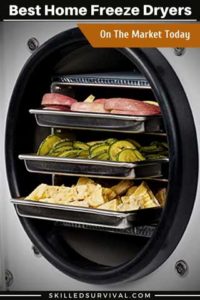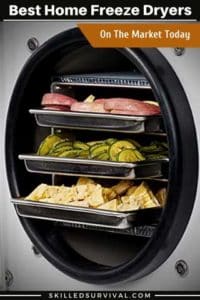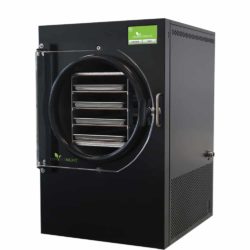If You’re Looking To Buy A Freeze Dryer, you’ve Come To The Right Place

But I’m betting that’s about to change!
I envision a future where nearly every home has a freeze dryer, and food waste becomes a thing of the past.
Where everyone can enjoy the incredible benefits of freeze-drying AT HOME.
And even though it may seem like a huge effort to freeze dry at home, it’s not bad at all.
Once you fully understand how they work and look at all your options, you’ll be ready to invest in this innovative technology.
So today, I’m going tap into my Mechanical Engineering expertise, years in food manufacturing and decade+ of preparedness knowledge to teach you:
TABLE OF CONTENTS
What Is A Freeze Dryer?
How Freeze Drying Works
Benefits Of Owning One
Downside Of Owning One
Best Freezer Dryer Features
Best Freeze Dryers On Sale
DIY Freeze Dryer Options
Best Foods To Freeze Dry
Are You Ready For The Tough Times Ahead? Take My 60 Sec Quiz To See If You’re Part Of ‘The Fragile Masses’ Or Not… Start Quiz Now!
What Is A Freeze Dryer?
A freeze dryer machine is simply an appliance that removes nearly all the moisture from foods.
There are several important benefits to removing moisture from food (which we’ll get into later), the primary benefit being an incredibly long shelf life.
And when it comes to food preservation and reduced food waste, it’s all about improved shelf life.
So now that you know what a freeze dryer is let’s discuss HOW they work.
How Freeze Drying Works
Before we discuss how freezing drying works, let’s talk about how it doesn’t work!
You see, many people get the process of freeze-drying confused with dehydration.
Why? Because freeze-drying and dehydration are two food preservation methods. And both methods remove water from food products. That’s why a lot of people mistakenly use the two terms interchangeably.
But there are major differences between dehydrated and freeze-dried food storage. First, let’s briefly discuss dehydration.
The Process of Dehydration
Modern-day dehydration is a pretty simple process that nearly anyone can do at home.
Food dehydrators circulate hot, dry air across food on open racks. This causes the water to evaporate and the food to shrivel.
The temperatures are high enough to remove water but not enough to cook the food.
Despite this, you lose many of the vitamins and nutrients in the process. Plus, the taste and texture can often change dramatically.
Raisins, dates, and beef jerky are all examples of dehydrated foods.
The Process of Freeze Drying
On the other hand, freeze-drying is a more complex process. One that involves 3 main steps:
- Freezing
- Lowering pressure
- Removing the moisture through sublimation
↓ How Freeze Drying Works ↓
The end product is completely different than “dehydrated” foods. Because of this complexity, it takes dedicated, high-tech equipment to freeze dry food.
Like dehydrating, you place food on large open racks to allow for air circulation. But, instead of placing the food in a high temp environment, you load the racks into a vacuum chamber.
Then the freeze dryer lowers the temperature inside the vacuum chamber to an incredibly low temp (around -40deg F).
Once the food is completely frozen, a vacuum pump lowers the pressure inside the chamber. And then the temperature is slowly raised back to normal.
Due to the reduced pressure, the water in the food “sublimes.”
Sublimation is when solid ice changes directly into water vapor without ever becoming liquid.
The food gives up its water content without sacrificing texture, flavor, or nutrition.
The bottom line:
If you’ve seen someone rehydrate an entire lasagna on a backpacking trip (as I have), you’ll start to see the immense possibilities of owning a freeze dryer!
↓ Home Freeze Dried Food: Appearance, Taste & Nutrition ↓
As A Way To Introduce You To Skilled Survival, We’re Giving Away Our Family First Food Planning Guide. Click Here To Get Your FREE Copy Of It.
The Benefits Of Freeze-Drying Food
So, why choose it over dehydrating if it’s more complex?
More Moisture Removal
One of the main reasons to remove moisture from food is to prevent the spread of mold and bacteria.
All living organisms need moisture to thrive. So, lowering the water contents makes it nearly impossible for them to survive.
Most home dehydrators can remove about 90 to 95 percent of the water contained in foods.
By comparison, freeze-drying will remove up to 98 to 99 percent of moisture content.
The bottom line:
Freeze-drying food removes more moisture. Thus it has a much better shelf life than dehydrated foods.
Much Longer Shelf Life
The lower water content of freeze-dried foods allows for a much longer shelf life if stored properly. That’s why it’s considered one of the best non-perishable foods.
Freeze-dried meals properly sealed in mylar bags will keep their texture, flavor, and nutritional value for up to 25 years (or longer)!
Better Nutritional Content
Dehydrating food doesn’t change the fiber or iron content. But many vitamins and minerals begin to break down at higher temperatures.
Freeze-dried foods keep more of these valuable vitamins and minerals.
More Appealing Appearance & Composition
For most people, the biggest hurdle for dehydrated foods is taste and texture.
Freeze-dried foods keep the shape and color of fresh food. You can often rehydrate the food back to a similar original consistency!
For example:
Freeze-dried strawberries become soft again if you add a little water or place them in your mouth.
Lower Weight
The greater reduction in water content provides an extra reduction in weight.
This is great when you have to pack your food on your back for miles, and every ounce counts!
Less Cooking Time & Effort
Freeze-dried foods generally only need the addition of water to reconstitute them. Unlike the slow simmer, you have to do with dehydrated foods.
Depending on what you’re preparing, most freeze-dried foods will be ready to eat in less than 5 minutes.
This makes meal prep faster and easier for everyone – especially if backpacking or camping.
The Disadvantages Of Freeze-Drying Food
Of course, there are some serious drawbacks to freeze-drying foods.
Higher Price
Honestly, this IS the biggest factor for most people. But it’s a shame…
I get it; a food dehydrator can come in at under $50 – and they show up frequently at Goodwill.
By comparison, even a smaller model freeze dryer can cost more like $2000!
And on top of that, a freeze dryer will use electricity to operate.
If you run it full-time during the summer when fresh produce is rolling in from the garden, energy costs can add up.
↓ How Much Electricity Does A Freeze Dryer Use? ↓
But here are three ideas to make the cost of these machines much more palatable.
1. Get a group of friends to “co-own” a freeze dryer.
You could become a part-owner with friends or neighbors! Then you could share the freeze dryer for different parts of the year.
If you could find 4 other “investors,” you all could own a $2000 freeze dryer for about $500. Much more reasonable if you’re on a tighter budget.
2. Start a small business
Consider a freeze dryer as a small business adventure!
- You can loan the unit out to others for a set time frame…
- Or you could take other people’s foods and freeze-dry them.
- Or sell freeze-dried meals you pack yourself.
Customers could start off as friends, then neighbors. After that, you could consider farmers’ markets or even online sales.
3. They’ll pay for themselves if you compare it to the cost of store-bought freeze-dried foods
Another way to justify the expense is the compare the cost of buying an equivalent amount of freeze-dried food from the store.
With $2900, you can get about 295,000 calories worth of store-bought freeze-dried food.
For a typical family of four (1500 calories per person per day), that’s only about 1.5 months’ worth of emergency food.
On the other hand, with a home freeze dryer, you can freeze and store all your leftover or bulk discount food purchases or extra garden produce this year, next year, and on and on.
So if you use your dryer all the time, you end up saving money over time when you compare the cost of purchasing freeze-dried foods from a store.
↓ Harvest Right Freeze Dryer Vs. Store-bought Freeze Dried Food ↓
The bottom line:
Taking any of these approaches could help justify the upfront cost of buying a freeze-dryer.
And if you use it as a small business venture, your new freeze dryer investment could even turn a nice profit!
Fixed Process Volume
I’ve expanded my old reliable dehydrator 4 times. It now has many more drying racks than it did when I bought it.
This has given me a huge increase in the volume of food I can preserve.
Volume expansion is not as easy with a freeze-dryer.
This is because the food has to fit in a smaller vacuum chamber, and each run can take days to finish.
As A Way To Introduce You To Skilled Survival, We’re Giving Away Our #78 Item Complete Prepper Checklist. Click Here To Get Your FREE Copy Of It.
Best Freeze Dryer Features
If you’ve made the decision to get a freeze dryer, you still need to ask some key questions before investing:
↓ Watch This BEFORE You Get A Freeze Dryer! ↓
How much food do you need to preserve?
Most freeze dryers give stats on the size of the vacuum chamber and the amount of food that can fit in one batch.
If you plan on smaller batches (i.e., you’re only “cooking” for yourself and a partner), you can get away with a smaller dryer.
If you need to provide for a crowd or you plan to do more than one food type in a batch, you’ll likely need a larger dryer.
How much space do you have for a large appliance?
Just like any other appliance, a freeze dryer takes up a lot of space. Plus, the vacuum chamber, the control system, and the pumps add to the footprint.
Some smaller ones can fit on a countertop, but the large ones are roughly the size of a dishwasher.
How much electricity can you provide for the freeze dryer?
The large pump and other machinery involved in freeze drying can take serious power.
You may need a dedicated electrical circuit for the larger models.
What maintenance are you willing to do?
Most home freeze dryers are fairly easy to maintain. But they do need cleaning and inspecting the door seals and other critical parts.
Also, some models come with a vacuum pump that requires oil changes.
Some allow for an upgrade to an oil-free pump, but it comes at a premium.
↓ Freeze Drying 101: Understanding The Cost Of Using A Freeze Dryer ↓
As A Way To Introduce You To Skilled Survival, We’re Giving Away Our Family First Food Planning Guide. Click Here To Get Your FREE Copy Of It.
Best Home Freeze Dryers For Sale Today
When it comes to freeze dryers, there’s really only one name on the market these days – Harvest Right.
Other manufacturers make solid, well-built freeze-drying machines. But most of these units are for the industrial market instead of for “in-home” use.
These commercial units do occasionally come up for sale on auction sites. And a used commercial freeze dryer can be a GREAT deal if you find the right one for your uses.
For the rest of us, there are three models from Harvest Right (small, medium, and large).
All three units are essentially the same except for their dimensions and price.
But all three sizes have several color options to choose from, to help match any kitchen decor.
Small Harvest Right Freeze Dryer
The Small Harvest Right Freeze Dryer is ideal for someone just getting into at-home freeze drying.
It can freeze dry anywhere from 4-7 LBS of fresh food per batch, translating into about 840 LBS of fresh food annually!
The size of the Small Harvest Right Freeze Dryer is 25 inches tall, 16.5 inches wide, and 18.5″ deep.
If you’re hoping to buy a freeze dryer that can fit on a kitchen countertop, this is the only unit I know of that can do it.
But even then, it is still a fairly large appliance for a countertop. Be aware of your headspace and depth to ensure it will fit – if this is your goal.
Medium Harvest Right Freeze Dryer
The Medium Harvest Right Model can take up to 7 to 10 lbs of fresh food per batch.
This is a decent amount of volume while not requiring the dedicated circuit that the Large unit may need.
The dimensions of the medium unit are 28.5 inches tall, 18 inches wide, and 21.25 inches deep.
It’s a good compromise on price, size, and capacity.
↓ Harvest Right Freeze Dryer Medium Size Review ↓
<iframe loading="lazy" title="Harvest Right Freeze Dryer Medium Burn Cycle





